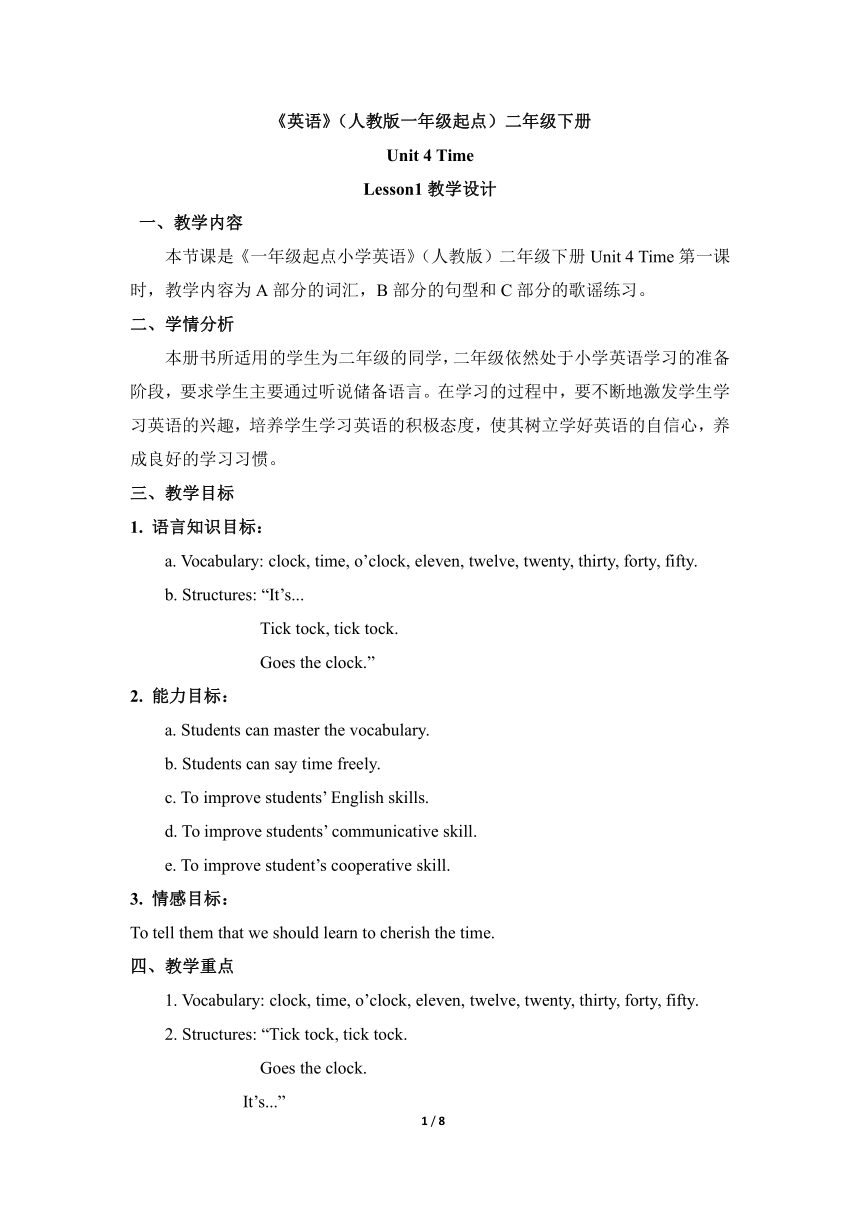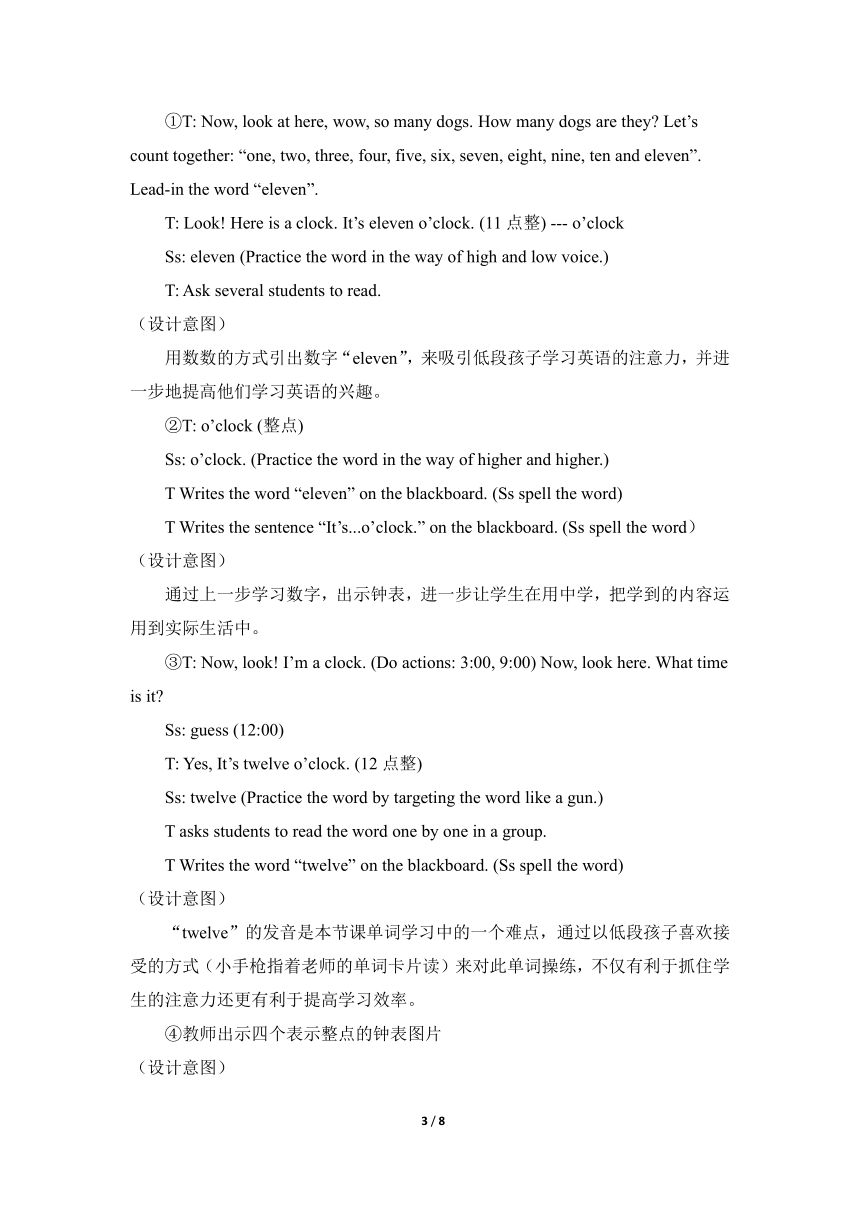Unit 4 Time Lesson 1 教案(含反思)
文档属性
| 名称 | Unit 4 Time Lesson 1 教案(含反思) |  | |
| 格式 | zip | ||
| 文件大小 | 165.1KB | ||
| 资源类型 | 教案 | ||
| 版本资源 | 人教(新起点) | ||
| 科目 | 英语 | ||
| 更新时间 | 2019-12-25 15:24:21 | ||
图片预览




文档简介
《英语》(人教版一年级起点)二年级下册
Unit
4
Time
Lesson1教学设计
一、教学内容
本节课是《一年级起点小学英语》(人教版)二年级下册Unit
4
Time第一课时,教学内容为A部分的词汇,B部分的句型和C部分的歌谣练习。
二、学情分析
本册书所适用的学生为二年级的同学,二年级依然处于小学英语学习的准备阶段,要求学生主要通过听说储备语言。在学习的过程中,要不断地激发学生学习英语的兴趣,培养学生学习英语的积极态度,使其树立学好英语的自信心,养成良好的学习习惯。
三、教学目标
1.
语言知识目标:
a.
Vocabulary:
clock,
time,
o’clock,
eleven,
twelve,
twenty,
thirty,
forty,
fifty.
b.
Structures:
“It’s...
Tick
tock,
tick
tock.
Goes
the
clock.”
2.
能力目标:
a.
Students
can
master
the
vocabulary.
b.
Students
can
say
time
freely.
c.
To
improve
students’
English
skills.
d.
To
improve
students’
communicative
skill.
e.
To
improve
student’s
cooperative
skill.
3.
情感目标:
To
tell
them
that
we
should
learn
to
cherish
the
time.
四、教学重点
1.
Vocabulary:
clock,
time,
o’clock,
eleven,
twelve,
twenty,
thirty,
forty,
fifty.
2.
Structures:
“Tick
tock,
tick
tock.
Goes
the
clock.
It’s...”
五、教学难点
1.
Vocabulary:
“twelve,
thirty”.
2.
Make
a
new
chant
according
the
chant
in
lesson
1.
六、设计理念
让学生通过单词、句型、歌谣,词不离句的学习方式,建构英语语言知识,懂得生活与学习的密切关系,且学会在生活中不断学习新知识,并为生活更好地服务。
七、教学准备
Computer,
PPT,
stickers,
blackboard,
chalk,
Hite
Board
八、教学过程
Step
1
Warming
up
(热身活动)
Sing
the
song
“Ten
little
Indians”
and
do
some
actions.
(设计意图)
在本环节中,老师请一位同学上台,带领同学们一起边唱歌曲边做动作。只要目的在于吸引学生的课堂注意力、活跃课堂气氛,为新课程教学做好准备。
Step
2
Lead-in
①T:
We
had
reviewed
numbers
one
to
ten.
Now,
I
will
show
you
the
sound.
Let’s
listen.
What’s
this
S1:
The
bell.
T:
Yes,
the
sound
is
from
the
clock.
(Show
the
sentence
“Tick
tock,
tick
tock.”
on
PPT
and
practice.
Show
the
picture
of
the
“clock”
and
practice
the
word
“clock”.)
②Show
more
pictures
to
lead-in
the
title
“Time”.(Clap
hands
and
practice
the
word
“time”.)
(设计意图)
用钟表图片导入本单元标题:“Time”,让学生更直观地意识到了本节课的主要内容,大大地吸引了学生的注意力,调动了学生学习的主动性,为之后的词汇学习打好了基础,大大地提高课堂效率。
Step
3
Presentation
①T:
Now,
look
at
here,
wow,
so
many
dogs.
How
many
dogs
are
they
Let’s
count
together:
“one,
two,
three,
four,
five,
six,
seven,
eight,
nine,
ten
and
eleven”.
Lead-in
the
word
“eleven”.
T:
Look!
Here
is
a
clock.
It’s
eleven
o’clock.
(11点整)
---
o’clock
Ss:
eleven
(Practice
the
word
in
the
way
of
high
and
low
voice.)
T:
Ask
several
students
to
read.
(设计意图)
用数数的方式引出数字“eleven”,来吸引低段孩子学习英语的注意力,并进一步地提高他们学习英语的兴趣。
②T:
o’clock
(整点)
Ss:
o’clock.
(Practice
the
word
in
the
way
of
higher
and
higher.)
T
Writes
the
word
“eleven”
on
the
blackboard.
(Ss
spell
the
word)
T
Writes
the
sentence
“It’s...o’clock.”
on
the
blackboard.
(Ss
spell
the
word)
(设计意图)
通过上一步学习数字,出示钟表,进一步让学生在用中学,把学到的内容运用到实际生活中。
③T:
Now,
look!
I’m
a
clock.
(Do
actions:
3:00,
9:00)
Now,
look
here.
What
time
is
it
Ss:
guess
(12:00)
T:
Yes,
It’s
twelve
o’clock.
(12点整)
Ss:
twelve
(Practice
the
word
by
targeting
the
word
like
a
gun.)
T
asks
students
to
read
the
word
one
by
one
in
a
group.
T
Writes
the
word
“twelve”
on
the
blackboard.
(Ss
spell
the
word)
(设计意图)
“twelve”的发音是本节课单词学习中的一个难点,通过以低段孩子喜欢接受的方式(小手枪指着老师的单词卡片读)来对此单词操练,不仅有利于抓住学生的注意力还更有利于提高学习效率。
④教师出示四个表示整点的钟表图片
(设计意图)
通过出示四个表示整点的钟表图片,让学生进一步练习表达整点。
⑤Show
students
a
math
work:
and
ask
students
to
work
it
out.10+10=20→“twenty”
Ss:
twenty
(Practice
the
word
in
the
way
of
higher
and
lower
voice.)
T
Writes
the
word
“twenty”
on
the
blackboard.
(Ss
spell
the
word)
T
shows
students
a
clock
on
PPT
and
asks
students
to
read
the
sentence.
Ss:
It’s
eleven
twenty.
(设计意图)
通过“算一算”的方式引出“twenty”,逐步锻炼学生的逻辑思维能力和语言转换能力。
⑥T
Shows
students
real
clock.
(12:30)
T:
It’s
eleven
thirty.→“thirty”
Ss:
thirty
(Practice
the
word
in
the
way
of
group
work)
T
asks
students
to
read
the
word
pairs
by
pairs
in
one
group.
T
writes
the
word
“thirty”
on
the
blackboard.
(Ss
spell
the
word)
(设计意图)
利用实物钟表引出“thirty”结合句型教学单词,使单词教学具有了语境的生合力,又在一定程度上,抓住了学生的注意力。
⑦T
shows
students
a
clock
(12:40)
→
Ss:
“forty”
(T
divides
students
into
two
groups
“boys
and
girls”.
By
using
left
and
right
hand
to
let
boys
and
girls
read.)
T
writes
the
word
“forty”
on
the
blackboard.
(Ss
spell
the
word)
T:
It’s
twelve
forty.
Ss:
It’s
twelve
forty.
⑧T
shows
students
a
real
clock
too.
(12:50)
T:
It’s
twelve
fifty.→“fifty”
Ss:
fifty.
(Students
practice
the
word
by
the
way
of
blowing
the
balloons.)
T
asks
several
students
to
read
the
word.
T:
It’s
twelve
fifty.
Ss:
It’s
twelve
fifty.
T
writes
the
word
“fifty”
on
the
blackboard.
(Ss
spell
the
word)
Step
4
Consolidation
(games)
1.
Golden
eyes.
2.
Who
is
the
fastest
one
(Ask
students
to
stand
up
to
tell
the
number
out.)
3.
Math
work.
(设计意图)
对于二年级的学生,课堂注意时间较为短暂,通过三种不同的游戏方式,帮助学生再次复习本节课的词汇、巩固本节课的重点,又一次地抓住了学生的注意力,同时又在一定程度上刺激了学生的好胜心,将课堂气氛推向高潮。
Step
5
Learn
the
new
chant.
(three
times.1st
time:
listen;
second
time:
learn
the
chant
sentence
by
sentence;
third
time:
learn
the
chant
together
and
do
actions.)
“Tick
tock,
tick
tock,
Goes
the
clock.
It’s
eleven
o’clock.”
“Tick
tock,
tick
tock,
Goes
the
clock.
It’s
eleven
twenty.”
“Tick
tock,
tick
tock,
Goes
the
clock.
It’s
eleven
thirty.”
“Tick
tock,
tick
tock,
Goes
the
clock.
It’s
eleven
forty.”
“Tick
tock,
tick
tock,
Goes
the
clock.
It’s
eleven
fifty.”
“Tick
tock,
tick
tock,
Goes
the
clock.
It’s
twelve
o’clock.”
(设计意图)
通过先听、后学的步骤,层层递进地让学生学会学习,逐步掌握歌谣的结构和节拍,以便学生更扎实地学习歌谣。
Step
6
Look
and
say
T:
What
time
are
they
You
may
work
in
groups
and
tell
me
the
time.
S:
It’s
three
thirty.
S:
It’s
two
o’clock.
S:
It’s
ten
forty.
S:
It’s
two
fifty.
(设计意图)
给学生出示四个钟表图,让学生学会在用中学,在学中用。
Step
7
Listen
and
number
(Listen
twice)
(设计意图)
本处设计了一项听力,通过听钟表时间,让学生排序,从而在学生说的基础上锻炼学生的听音能力,这也是对本节课的高度提炼和延伸。
Step
8
Give
student
three
groups
of
clocks
and
ask
students
to
make
a
new
chant.
T:
Give
an
example
(Tick
tock.
tick
tock,
goes
the
clock.
It’s
12:30)
Ss:
“Tick
tock.
Tick
tock,
goes
the
clock.
It’s
12:40.”
Ss:
“Tick
tock.
Tick
tock,
goes
the
clock.
It’s
12:50.”
Ss:
“Tick
tock.
Tick
tock,
goes
the
clock.
It’s
8:30.”
(设计意图)
让学生真正地学会在学中用,进一步给学生搭建学台,从而拓展学生的思维能力和培养学习能力。
Step
9
Group
work
(four
students
in
a
group
to
make
a
chant
according
to
the
clock
T
provides.)
(设计意图)
本处的小组学习旨在培养学生的合作精神和合作能力。
Step
10:
Show
time
(Ask
three
students
to
show
their
new
chants.)
(设计意图)
老师给学生一次展示的机会,为学生提供了展示自我的平台,旨在让学生能够把书本知识转化成内在的知识和能力,不断地让学生学会展示自我、锻炼自我、提高自信心。
Step
11
Time
in
life
(T
shows
students
three
pictures.
)
(设计意图)
本处展示了三张图片,来说明生活中时间无处不在,旨在让学生将书本知识回归生活,树立生活观念和时间观念。
Step
12
Emotion:
We
should
learn
to
cherish
the
time!
(设计意图)
出示情感目标让学生再次铭记一定要珍惜时间。
Step
13
Homework
A.
1.
Practice
the
six
new
numbers.
(练习新学的六个数字。)
2.
Try
to
say
time
in
English
in
daily
life.
(在生活中试着用英语表达时间。)
B.
Try
to
make
a
new
chant.
(试着编一个至少含有三个时间点的新歌谣。)
(A项必做、B项选做。)
(设计意图)
共设有A、B两项作业,A项为必做,旨在要求学生对课本知识进行复习和巩固,让学生在生活中运用学到的知识。B项为选做,旨在锻炼学生的口语表达能力。
板书设计
(设计意图)
图文结合,突出重点,吸引学生的注意力,加深学习印象。
课后反思
本节课是二年级下册第四单元的第一课,是一节新授课,依据新课程标准,
小学一二年级的教学任务主要是:培养学生的听、说能力。本节课本着培养、训练学生的听、说能力,在活动设计中加入了对学生说的训练和听音训练。本节课新授单词操练扎实、有效;活动、游戏设计新颖、层次性、目的性强;教学环节环环相扣;教学重难点把握透彻。但是,本节课还存在一些不足之处:①由于是新授课,老师说得比学生多,老师应该起到引导的作用,所以导致本节课中学生的主动性不是很突出。②由于时间关系,参与展示活动的学生比较少,对学生的关注面不够广,对于极个别学生关注度太高;这应在以后的课堂中多注意。③教授单词时重复太多,应该放手让学生去读。我会在以后的教学当中更加严格地要求自己,多听课,多跟老教师学习,多向组里的老师请教,“多读书、读好书”,提升自身的理论素养、专业素养,提升教学艺术素养。不断总结经验,继续认真备课,深刻反思,提高自身能力,争取更大的进步。
1
/
8
Unit
4
Time
Lesson1教学设计
一、教学内容
本节课是《一年级起点小学英语》(人教版)二年级下册Unit
4
Time第一课时,教学内容为A部分的词汇,B部分的句型和C部分的歌谣练习。
二、学情分析
本册书所适用的学生为二年级的同学,二年级依然处于小学英语学习的准备阶段,要求学生主要通过听说储备语言。在学习的过程中,要不断地激发学生学习英语的兴趣,培养学生学习英语的积极态度,使其树立学好英语的自信心,养成良好的学习习惯。
三、教学目标
1.
语言知识目标:
a.
Vocabulary:
clock,
time,
o’clock,
eleven,
twelve,
twenty,
thirty,
forty,
fifty.
b.
Structures:
“It’s...
Tick
tock,
tick
tock.
Goes
the
clock.”
2.
能力目标:
a.
Students
can
master
the
vocabulary.
b.
Students
can
say
time
freely.
c.
To
improve
students’
English
skills.
d.
To
improve
students’
communicative
skill.
e.
To
improve
student’s
cooperative
skill.
3.
情感目标:
To
tell
them
that
we
should
learn
to
cherish
the
time.
四、教学重点
1.
Vocabulary:
clock,
time,
o’clock,
eleven,
twelve,
twenty,
thirty,
forty,
fifty.
2.
Structures:
“Tick
tock,
tick
tock.
Goes
the
clock.
It’s...”
五、教学难点
1.
Vocabulary:
“twelve,
thirty”.
2.
Make
a
new
chant
according
the
chant
in
lesson
1.
六、设计理念
让学生通过单词、句型、歌谣,词不离句的学习方式,建构英语语言知识,懂得生活与学习的密切关系,且学会在生活中不断学习新知识,并为生活更好地服务。
七、教学准备
Computer,
PPT,
stickers,
blackboard,
chalk,
Hite
Board
八、教学过程
Step
1
Warming
up
(热身活动)
Sing
the
song
“Ten
little
Indians”
and
do
some
actions.
(设计意图)
在本环节中,老师请一位同学上台,带领同学们一起边唱歌曲边做动作。只要目的在于吸引学生的课堂注意力、活跃课堂气氛,为新课程教学做好准备。
Step
2
Lead-in
①T:
We
had
reviewed
numbers
one
to
ten.
Now,
I
will
show
you
the
sound.
Let’s
listen.
What’s
this
S1:
The
bell.
T:
Yes,
the
sound
is
from
the
clock.
(Show
the
sentence
“Tick
tock,
tick
tock.”
on
PPT
and
practice.
Show
the
picture
of
the
“clock”
and
practice
the
word
“clock”.)
②Show
more
pictures
to
lead-in
the
title
“Time”.(Clap
hands
and
practice
the
word
“time”.)
(设计意图)
用钟表图片导入本单元标题:“Time”,让学生更直观地意识到了本节课的主要内容,大大地吸引了学生的注意力,调动了学生学习的主动性,为之后的词汇学习打好了基础,大大地提高课堂效率。
Step
3
Presentation
①T:
Now,
look
at
here,
wow,
so
many
dogs.
How
many
dogs
are
they
Let’s
count
together:
“one,
two,
three,
four,
five,
six,
seven,
eight,
nine,
ten
and
eleven”.
Lead-in
the
word
“eleven”.
T:
Look!
Here
is
a
clock.
It’s
eleven
o’clock.
(11点整)
---
o’clock
Ss:
eleven
(Practice
the
word
in
the
way
of
high
and
low
voice.)
T:
Ask
several
students
to
read.
(设计意图)
用数数的方式引出数字“eleven”,来吸引低段孩子学习英语的注意力,并进一步地提高他们学习英语的兴趣。
②T:
o’clock
(整点)
Ss:
o’clock.
(Practice
the
word
in
the
way
of
higher
and
higher.)
T
Writes
the
word
“eleven”
on
the
blackboard.
(Ss
spell
the
word)
T
Writes
the
sentence
“It’s...o’clock.”
on
the
blackboard.
(Ss
spell
the
word)
(设计意图)
通过上一步学习数字,出示钟表,进一步让学生在用中学,把学到的内容运用到实际生活中。
③T:
Now,
look!
I’m
a
clock.
(Do
actions:
3:00,
9:00)
Now,
look
here.
What
time
is
it
Ss:
guess
(12:00)
T:
Yes,
It’s
twelve
o’clock.
(12点整)
Ss:
twelve
(Practice
the
word
by
targeting
the
word
like
a
gun.)
T
asks
students
to
read
the
word
one
by
one
in
a
group.
T
Writes
the
word
“twelve”
on
the
blackboard.
(Ss
spell
the
word)
(设计意图)
“twelve”的发音是本节课单词学习中的一个难点,通过以低段孩子喜欢接受的方式(小手枪指着老师的单词卡片读)来对此单词操练,不仅有利于抓住学生的注意力还更有利于提高学习效率。
④教师出示四个表示整点的钟表图片
(设计意图)
通过出示四个表示整点的钟表图片,让学生进一步练习表达整点。
⑤Show
students
a
math
work:
and
ask
students
to
work
it
out.10+10=20→“twenty”
Ss:
twenty
(Practice
the
word
in
the
way
of
higher
and
lower
voice.)
T
Writes
the
word
“twenty”
on
the
blackboard.
(Ss
spell
the
word)
T
shows
students
a
clock
on
PPT
and
asks
students
to
read
the
sentence.
Ss:
It’s
eleven
twenty.
(设计意图)
通过“算一算”的方式引出“twenty”,逐步锻炼学生的逻辑思维能力和语言转换能力。
⑥T
Shows
students
real
clock.
(12:30)
T:
It’s
eleven
thirty.→“thirty”
Ss:
thirty
(Practice
the
word
in
the
way
of
group
work)
T
asks
students
to
read
the
word
pairs
by
pairs
in
one
group.
T
writes
the
word
“thirty”
on
the
blackboard.
(Ss
spell
the
word)
(设计意图)
利用实物钟表引出“thirty”结合句型教学单词,使单词教学具有了语境的生合力,又在一定程度上,抓住了学生的注意力。
⑦T
shows
students
a
clock
(12:40)
→
Ss:
“forty”
(T
divides
students
into
two
groups
“boys
and
girls”.
By
using
left
and
right
hand
to
let
boys
and
girls
read.)
T
writes
the
word
“forty”
on
the
blackboard.
(Ss
spell
the
word)
T:
It’s
twelve
forty.
Ss:
It’s
twelve
forty.
⑧T
shows
students
a
real
clock
too.
(12:50)
T:
It’s
twelve
fifty.→“fifty”
Ss:
fifty.
(Students
practice
the
word
by
the
way
of
blowing
the
balloons.)
T
asks
several
students
to
read
the
word.
T:
It’s
twelve
fifty.
Ss:
It’s
twelve
fifty.
T
writes
the
word
“fifty”
on
the
blackboard.
(Ss
spell
the
word)
Step
4
Consolidation
(games)
1.
Golden
eyes.
2.
Who
is
the
fastest
one
(Ask
students
to
stand
up
to
tell
the
number
out.)
3.
Math
work.
(设计意图)
对于二年级的学生,课堂注意时间较为短暂,通过三种不同的游戏方式,帮助学生再次复习本节课的词汇、巩固本节课的重点,又一次地抓住了学生的注意力,同时又在一定程度上刺激了学生的好胜心,将课堂气氛推向高潮。
Step
5
Learn
the
new
chant.
(three
times.1st
time:
listen;
second
time:
learn
the
chant
sentence
by
sentence;
third
time:
learn
the
chant
together
and
do
actions.)
“Tick
tock,
tick
tock,
Goes
the
clock.
It’s
eleven
o’clock.”
“Tick
tock,
tick
tock,
Goes
the
clock.
It’s
eleven
twenty.”
“Tick
tock,
tick
tock,
Goes
the
clock.
It’s
eleven
thirty.”
“Tick
tock,
tick
tock,
Goes
the
clock.
It’s
eleven
forty.”
“Tick
tock,
tick
tock,
Goes
the
clock.
It’s
eleven
fifty.”
“Tick
tock,
tick
tock,
Goes
the
clock.
It’s
twelve
o’clock.”
(设计意图)
通过先听、后学的步骤,层层递进地让学生学会学习,逐步掌握歌谣的结构和节拍,以便学生更扎实地学习歌谣。
Step
6
Look
and
say
T:
What
time
are
they
You
may
work
in
groups
and
tell
me
the
time.
S:
It’s
three
thirty.
S:
It’s
two
o’clock.
S:
It’s
ten
forty.
S:
It’s
two
fifty.
(设计意图)
给学生出示四个钟表图,让学生学会在用中学,在学中用。
Step
7
Listen
and
number
(Listen
twice)
(设计意图)
本处设计了一项听力,通过听钟表时间,让学生排序,从而在学生说的基础上锻炼学生的听音能力,这也是对本节课的高度提炼和延伸。
Step
8
Give
student
three
groups
of
clocks
and
ask
students
to
make
a
new
chant.
T:
Give
an
example
(Tick
tock.
tick
tock,
goes
the
clock.
It’s
12:30)
Ss:
“Tick
tock.
Tick
tock,
goes
the
clock.
It’s
12:40.”
Ss:
“Tick
tock.
Tick
tock,
goes
the
clock.
It’s
12:50.”
Ss:
“Tick
tock.
Tick
tock,
goes
the
clock.
It’s
8:30.”
(设计意图)
让学生真正地学会在学中用,进一步给学生搭建学台,从而拓展学生的思维能力和培养学习能力。
Step
9
Group
work
(four
students
in
a
group
to
make
a
chant
according
to
the
clock
T
provides.)
(设计意图)
本处的小组学习旨在培养学生的合作精神和合作能力。
Step
10:
Show
time
(Ask
three
students
to
show
their
new
chants.)
(设计意图)
老师给学生一次展示的机会,为学生提供了展示自我的平台,旨在让学生能够把书本知识转化成内在的知识和能力,不断地让学生学会展示自我、锻炼自我、提高自信心。
Step
11
Time
in
life
(T
shows
students
three
pictures.
)
(设计意图)
本处展示了三张图片,来说明生活中时间无处不在,旨在让学生将书本知识回归生活,树立生活观念和时间观念。
Step
12
Emotion:
We
should
learn
to
cherish
the
time!
(设计意图)
出示情感目标让学生再次铭记一定要珍惜时间。
Step
13
Homework
A.
1.
Practice
the
six
new
numbers.
(练习新学的六个数字。)
2.
Try
to
say
time
in
English
in
daily
life.
(在生活中试着用英语表达时间。)
B.
Try
to
make
a
new
chant.
(试着编一个至少含有三个时间点的新歌谣。)
(A项必做、B项选做。)
(设计意图)
共设有A、B两项作业,A项为必做,旨在要求学生对课本知识进行复习和巩固,让学生在生活中运用学到的知识。B项为选做,旨在锻炼学生的口语表达能力。
板书设计
(设计意图)
图文结合,突出重点,吸引学生的注意力,加深学习印象。
课后反思
本节课是二年级下册第四单元的第一课,是一节新授课,依据新课程标准,
小学一二年级的教学任务主要是:培养学生的听、说能力。本节课本着培养、训练学生的听、说能力,在活动设计中加入了对学生说的训练和听音训练。本节课新授单词操练扎实、有效;活动、游戏设计新颖、层次性、目的性强;教学环节环环相扣;教学重难点把握透彻。但是,本节课还存在一些不足之处:①由于是新授课,老师说得比学生多,老师应该起到引导的作用,所以导致本节课中学生的主动性不是很突出。②由于时间关系,参与展示活动的学生比较少,对学生的关注面不够广,对于极个别学生关注度太高;这应在以后的课堂中多注意。③教授单词时重复太多,应该放手让学生去读。我会在以后的教学当中更加严格地要求自己,多听课,多跟老教师学习,多向组里的老师请教,“多读书、读好书”,提升自身的理论素养、专业素养,提升教学艺术素养。不断总结经验,继续认真备课,深刻反思,提高自身能力,争取更大的进步。
1
/
8
